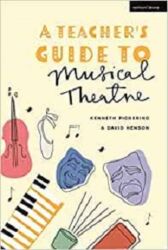Synopsis
A Teacher’s Guide to Musical Theatre
Kenneth Pickering & David Henson
Published by Methuen Drama
Are you a teacher of musical theatre who struggles to plan and construct lessons?
Are you looking for a structured approach to teaching musical theatre to students of all abilities?
Do you know your Ivor Novello from your Stephen Sondheim?
Despite being one of the most popular forms of performance study, Musical Theatre is often the most difficult to teach due to its part-practical and part-academic approach
With few books on the market directly aimed at teachers, it can be a challenging and daunting task to devise a course of study that takes in the history of the form as well as considering the wider aspects that come together to make a successful musical
A Teacher's Guide to Musical Theatre enables teachers to plan and deliver courses in Musical Theatre with confidence and flair
The unique structure of the chapters guides teachers through key facts and concepts in musical theatre history and offers practical in-class activities for students
From topics for class discussion and essay assignments to journal entries and portfolios to sample test questions, this book is full of practical advice from experienced teachers in the field which make it the ideal companion for teachers and instructors on diploma and degree-level courses, as well as those devising courses in part-time performing arts schools
Devised to provide sufficient engaging and inspirational material for an initial term or semester, the book establishes the principles of teaching this relatively new subject and encourages teachers to extend much further into the subject
From The Mikado to Hamilton and everything in between, this book breaks down decades of history into appropriately sized lessons, designed to give students a rounded survey of the subject and an understanding of how musicals work
Offering expert guidance to those with varied fields of expertise and practical experience but limited teaching experience, this book is the only existing guide to structured and stimulating practice
Table of Contents
1. An introduction to the teaching of musical theatre
Establishing the principles of effective teaching in this field and emphasising the integrated nature of the subject, this chapter explains how the book may be used in a variety of ways. Each 'lesson' is envisaged as 2 x50 mins in a typical twelve- week semester
2. Lesson One: The Elements of Musical Theatre
Using a simple narrative song as an example, this chapter explores and establishes the basic elements and possibilities of musical theatre
3. Lesson Two: What do you mean?
Acting in musical theatre. This chapter establishes the concept of 'acting through song' and provides the basis for performance approaches throughout the book
4. Lesson Three: Play the dots? The art and use of accompaniment. The chapter discusses the use of various forms of accompaniment and establishes the best ways for teachers to work with live and recorded music
5. Lesson Four: 'I could have danced all night': What about choreography?
What and how do we teach the integration of music, movement and acting? What is the purpose of dance and how has the 'dance musical' evolved? Projects and explorations involving various dance forms and the role of the choreographer
6. Lesson Five: Where did it all start?
Exploring the history of the development of this art form to enable students to place their work in context
7. Lesson Six: The 'Biz'.
Here we look at the way in which the theatre often celebrates and explores itself through shows, e.g. 'Cabaret' 'Sweet Charity',' Kiss me Kate', 'A Chorus Line'
8. Lesson Seven: 'Pogroms in the East'
Some key historical facts describing the effect of migration from the Opera Houses of Europe to the USA by predominantly Jewish musicians. We then consider the diversity of musical theatre and the influences of black culture; minstrel shows and jazz together with the influence of various other ethnic groups. The creation of the Broadway and Hollywood musical scene
9. Lesson Eight: Chorus time.
Many students regard being cast as a member of the chorus as a disappointment, but the chorus is now an integral 'main character'. This was not always the case, (see Berlioz and his comment on the behaviour of the chorus in Paris Opera Houses in his 'Memoirs' and G and S's work to eradicate this lack of discipline etc). We now explore precisely what a chorus does in 'A Chorus Line' or 'JCSS' and create tasks to develop the ideas touched in on Lesson One
10. Lesson Nine: Patter, Hamilton and Gilbert and Sullivan.
The recent revival of 'The Mikado' by Jonathan Miller, (giving it an 'after life' as he likes to call it), suggests that we ought to reintroduce the work of G and S to a generation that is largely ignorant of it and then link the patter songs with the rap of 'Hamilton'
 $22.99
$22.99